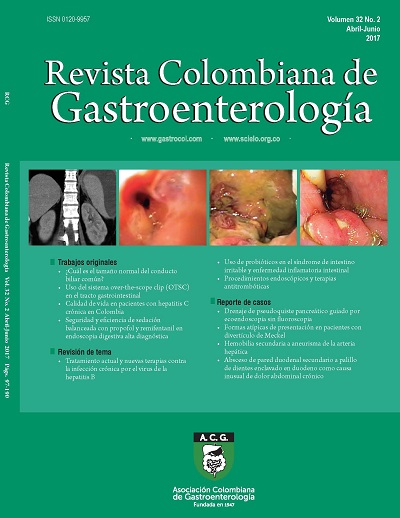Tratamiento actual y nuevas terapias contra la infección crónica por el virus de la Hepatitis B
DOI:
https://doi.org/10.22516/25007440.138Palabras clave:
Virus de la Hepatitis B, Inmunoterapia, Antivirales, Hepatitis crónica, Cirrosis HepáticaResumen
La infección crónica por el virus de la hepatitis B es un grave problema de salud pública a nivel mundial. Sus consecuencias llegan a ser mortales y el tratamiento actual no ofrece curación sino control de la enfermedad. Las principales limitantes para una cura son la dificultad para destruir el ADNccc del virus en el núcleo celular y la presencia de material genético viral integrado en el ADN de la célula hospedera. No obstante, hay múltiples frentes de investigación enfocados en encontrar una cura definitiva al potenciar la respuesta inmune del hospedero o al actuar directamente contra el virus y su ciclo de replicación. En este artículo se exponen los principales avances que se han realizado en este campo.
Descargas
Lenguajes:
esReferencias bibliográficas
Zhou Y, Holmes EC. Bayesian estimates of the evolutionary rate and age of hepatitis B virus. J Mol Evol. 2007;65(2):197-205.
https://doi.org/10.1007/s00239-007-0054-1
Blumberg BS, Alter HJ, Visnich S. A «NEW» ANTIGEN IN LEUKEMIA SERA. JAMA.1965;191:541-6. doi: https://doi.org/10.1001/jama.1965.03080070025007
Blumberg BS, Gerstley BJ, Hungerford DA, London WT, Sutnick AI. A serum antigen (Australia antigen) in Down's syndrome, leukemia, and hepatitis. Ann Intern Med. 1967; 66(5): 924-31. doi: https://doi.org/10.7326/0003-4819-66-5-924 - https://doi.org/10.7326/0003-4819-66-5-1040_2
Araujo NM. Hepatitis B virus intergenotypic recombinants worldwide: An overview. Infect Genet Evol. 2015; 36:500-10. doi: https://doi.org/10.1016/j.meegid.2015.08.024
World Health Organization. Hepatitis B. Fact sheet No. 204 (Citado 05 de mayo de 2016. Disponible en: http://www.who.int/mediacentre/factsheets/fs204/en/
D'Souza R, Foster GR. Diagnosis and treatment of chronic hepatitis B. J R Soc Med. 2004; 97(7):318-21. doi: https://doi.org/10.1258/jrsm.97.7.318
Chen C-J, Chen D-S. Interaction of hepatitis B virus, chemical carcinogen, and genetic susceptibility: multistage hepatocarcinogenesis with multifactorial etiology. Hepatol Baltim Md. 2002; 36(5): 1046-9. doi: https://doi.org/10.1053/jhep.2002.37084
Di Bisceglie AM. Hepatitis B And Hepatocellular Carcinoma. Hepatol Baltim Md. 2009; 49(5 Suppl): S56-60. doi: https://doi.org/10.1002/hep.22962
Hou J, Liu Z, Gu F. Epidemiology and Prevention of Hepatitis B Virus Infection. Int J Med Sci. 2005; 2(1):50-7. doi: https://doi.org/10.7150/ijms.2.50
Aljarbou AN. The Emergent Concern of Hepatitis B globally with special attention to Kingdom of Saudi Arabia. Int J Health Sci. 2013;7(3):333-40. doi: https://doi.org/10.12816/0006062
Thio CL, Hawkins C. Hepatitis B Virus and Hepatitis Delta Virus. En: Mandell, Douglas, and Bennett's Principles and Practice of Infectious Diseases. 8 edition. Elsevier; 2015. p. 1815-39.
European Association For The Study Of The Liver. EASL clinical practice guidelines: Management of chronic hepatitis B virus infection. J Hepatol. 2012;57(1):167-85. doi: https://doi.org/10.1016/j.jhep.2012.02.010
Kumar R, Pérez-Del-Pulgar S, Testoni B, Lebossé F, Zoulim F. Clinical relevance of the study of hepatitis B virus covalently closed circular DNA. Liver Int. 2016;36 Suppl 1:72-7. doi: https://doi.org/10.1111/liv.13001
Raimondo G, Allain J-P, Brunetto MR, Buendia M-A, Chen D-S, Colombo M, et al. Statements from the Taormina expert meeting on occult hepatitis B virus infection. J Hepatol. 2008;49(4):652-7. doi: https://doi.org/10.1016/j.jhep.2008.07.014
Chemin I, Zoulim F. Hepatitis B virus induced hepatocellular carcinoma. Cancer Lett. 2009;286(1):52-9. doi: https://doi.org/10.1016/j.canlet.2008.12.003
Alaluf MB, Shlomai A. New therapies for chronic hepatitis B. Liver Int. 2016;36(6):775-82. doi: https://doi.org/10.1111/liv.13086
Block TM, Rawat S, Brosgart CL. Chronic hepatitis B: A wave of new therapies on the horizon. Antiviral Res. 2015;121:69-81. doi: https://doi.org/10.1016/j.antiviral.2015.06.014
Gish RG, Given BD, Lai C-L, Locarnini SA, Lau JYN, Lewis DL, et al. Chronic hepatitis B: Virology, natural history, current management and a glimpse at future opportunities. Antiviral Res. 2015;121:47-58. doi: https://doi.org/10.1016/j.antiviral.2015.06.008
Yan H, Li W. Sodium taurocholate cotransporting polypeptide acts as a receptor for hepatitis B and D virus. Dig Dis Basel Switz. 2015;33(3):388-96. doi: https://doi.org/10.1159/000371692
Li W. The hepatitis B virus receptor. Annu Rev Cell Dev Biol. 2015;31:125-47. doi: https://doi.org/10.1146/annurev-cellbio-100814-125241
Lucifora J, Protzer U. Attacking hepatitis B virus cccDNA - The holy grail to hepatitis B cure. J Hepatol. 2016;64(1 Suppl):S41-48. doi: https://doi.org/10.1016/j.jhep.2016.02.009
Ganem D, Prince AM. Hepatitis B virus infection--natural history and clinical consequences. N Engl J Med. 2004;350(11):1118-29. doi: https://doi.org/10.1056/NEJMra031087
Yapali S, Talaat N, Lok AS. Management of hepatitis B: our practice and how it relates to the guidelines. Clin Gastroenterol Hepatol. 2014;12(1):16-26. doi: https://doi.org/10.1016/j.cgh.2013.04.036
Lok ASF, McMahon BJ. Chronic hepatitis B: update 2009. Hepatol Baltim Md. 2009;50(3):661-2. doi: https://doi.org/10.1002/hep.23190
Liaw Y-F, Kao J-H, Piratvisuth T, Chan HLY, Chien R-N, Liu C-J, et al. Asian-Pacific consensus statement on the management of chronic hepatitis B: a 2012 update. Hepatol Int. 2012;6(3):531-61. doi: https://doi.org/10.1007/s12072-012-9365-4
Janssen HLA, van Zonneveld M, Senturk H, Zeuzem S, Akarca US, Cakaloglu Y, et al. Pegylated interferon alfa-2b alone or in combination with lamivudine for HBeAg-positive chronic hepatitis B: a randomised trial. Lancet. 2005;365(9454):123-9. doi: https://doi.org/10.1016/S0140-6736(05)17701-0
Lau GKK, Piratvisuth T, Luo KX, Marcellin P, Thongsawat S, Cooksley G, et al. Peginterferon Alfa-2a, lamivudine, and the combination for HBeAg-positive chronic hepatitis B. N Engl J Med. 2005;352(26):2682-95. doi: https://doi.org/10.1056/NEJMoa043470
Chang T-T, Lai C-L, Kew Yoon S, Lee SS, Coelho HSM, Carrilho FJ, et al. Entecavir treatment for up to 5 years in patients with hepatitis B e antigen-positive chronic hepatitis B. Hepatol Baltim Md. 2010;51(2):422-30. doi: https://doi.org/10.1002/hep.23327
Bertoletti A, Tan AT, Gehring AJ. HBV-Specific Adaptive Immunity. Viruses. 2009;1(2):91-103. doi: https://doi.org/10.3390/v1020091
Shlomai A, Schwartz RE, Ramanan V, Bhatta A, de Jong YP, Bhatia SN, et al. Modeling host interactions with hepatitis B virus using primary and induced pluripotent stem cell-derived hepatocellular systems. Proc Natl Acad Sci U S A. 2014;111(33):12193-8. doi: https://doi.org/10.1073/pnas.1412631111
Takeuchi O, Akira S. Pattern recognition receptors and inflammation. Cell. 2010;140(6):805-20. doi: https://doi.org/10.1016/j.cell.2010.01.022
Guo F, Han Y, Zhao X, Wang J, Liu F, Xu C, et al. STING agonists induce an innate antiviral immune response against hepatitis B virus. Antimicrob Agents Chemother. 2015;59(2):1273-81. doi: https://doi.org/10.1128/AAC.04321-14
Luangsay S, Ait-Goughoulte M, Michelet M, Floriot O, Bonnin M, Gruffaz M, et al. Expression and functionality of Toll- and RIG-like receptors in HepaRG cells. J Hepatol. 2015;63(5):1077-85. doi: https://doi.org/10.1016/j.jhep.2015.06.022
Dalod M, Chelbi R, Malissen B, Lawrence T. Dendritic cell maturation: functional specialization through signaling specificity and transcriptional programming. EMBO J. 2014;33(10):1104-16. doi: https://doi.org/10.1002/embj.201488027
van der Aa E, van Montfoort N, Woltman AM. BDCA3(+)CLEC9A(+) human dendritic cell function and development. Semin Cell Dev Biol. 2015;41:39-48. doi: https://doi.org/10.1016/j.semcdb.2014.05.016
O'Neill AK, Niederst MJ, Newton AC. Suppression of survival signalling pathways by the phosphatase PHLPP. FEBS J. 2013;280(2):572-83. doi: https://doi.org/10.1111/j.1742-4658.2012.08537.x
Gane EJ, Lim Y-S, Gordon SC, Visvanathan K, Sicard E, Fedorak RN, et al. The oral toll-like receptor-7 agonist GS-9620 in patients with chronic hepatitis B virus infection. J Hepatol. 2015;63(2):320-8. doi: https://doi.org/10.1016/j.jhep.2015.02.037
Lanford RE, Guerra B, Chavez D, Giavedoni L, Hodara VL, Brasky KM, et al. GS-9620, an oral agonist of Toll-like receptor-7, induces prolonged suppression of hepatitis B virus in chronically infected chimpanzees. Gastroenterology. 2013;144(7):1508-17, 1517-10.
Menne S, Tumas DB, Liu KH, Thampi L, AlDeghaither D, Baldwin BH, et al. Sustained efficacy and seroconversion with the Toll-like receptor 7 agonist GS-9620 in the Woodchuck model of chronic hepatitis B. J Hepatol. 2015;62(6):1237-45. doi: https://doi.org/10.1016/j.jhep.2014.12.026
Fosdick A, Zheng J, Pflanz S, Frey CR, Hesselgesser J, Halcomb RL, et al. Pharmacokinetic and pharmacodynamic properties of GS-9620, a novel Toll-like receptor 7 agonist, demonstrate interferon-stimulated gene induction without detectable serum interferon at low oral doses. J Pharmacol Exp Ther. 2014;348(1):96-105. doi: https://doi.org/10.1124/jpet.113.207878
Wu J, Huang S, Zhao X, Chen M, Lin Y, Xia Y, et al. Poly(I:C) treatment leads to interferon-dependent clearance of hepatitis B virus in a hydrodynamic injection mouse model. J Virol. 2014;88(18):10421-31. doi: https://doi.org/10.1128/JVI.00996-14
Huang L-R, Wohlleber D, Reisinger F, Jenne CN, Cheng R-L, Abdullah Z, et al. Intrahepatic myeloid-cell aggregates enable local proliferation of CD8(+) T cells and successful immunotherapy against chronic viral liver infection. Nat Immunol. 2013;14(6):574-83. doi: https://doi.org/10.1038/ni.2573
Cai CW, Lomonosova E, Moran EA, Cheng X, Patel KB, Bailly F, et al. Hepatitis B virus replication is blocked by a 2-hydroxyisoquinoline-1,3(2H,4H)-dione (HID) inhibitor of the viral ribonuclease H activity. Antiviral Res. 2014;108:48-55. doi: https://doi.org/10.1016/j.antiviral.2014.05.007
Tsai S-L, Sheen I-S, Chien R-N, Chu C-M, Huang H-C, Chuang Y-L, et al. Activation of Th1 immunity is a common immune mechanism for the successful treatment of hepatitis B and C: tetramer assay and therapeutic implications. J Biomed Sci. 2003;10(1):120-35. doi: https://doi.org/10.1007/BF02256004
Grimm D, Thimme R, Blum HE. HBV life cycle and novel drug targets. Hepatol Int. 2011;5(2):644-53. doi: https://doi.org/10.1007/s12072-011-9261-3
You J, Zhuang L, Tang BZ, Yang WB, Ding SY, Li W, et al. A randomized controlled clinical trial on the treatment of Thymosin a1 versus interferon-alpha in patients with hepatitis B. World J Gastroenterol. 2001;7(3):411-4. doi: https://doi.org/10.3748/wjg.v7.i3.411
Saruc M, Ozden N, Turkel N, Ayhan S, Hock LM, Tuzcuoglu I, et al. Long-term outcomes of thymosin-alpha 1 and interferon alpha-2b combination therapy in patients with hepatitis B e antigen (HBeAg) negative chronic hepatitis B. J Pharm Sci. 2003;92(7):1386-95. doi: https://doi.org/10.1002/jps.10401
Zhang Y-Y, Chen E-Q, Yang J, Duan Y-R, Tang H. Treatment with lamivudine versus lamivudine and thymosin alpha-1 for e antigen-positive chronic hepatitis B patients: a meta-analysis. Virol J. 2009;6:63. doi: https://doi.org/10.1186/1743-422X-6-63
Kim BH, Lee Y-J, Kim W, Yoon J-H, Jung EU, Park SJ, et al. Efficacy of thymosin α-1 plus peginterferon α-2a combination therapy compared with peginterferon α-2a monotherapy in HBeAg-positive chronic hepatitis B: a prospective, multicenter, randomized, open-label study. Scand J Gastroenterol. 2012;47(8-9):1048-55. doi: https://doi.org/10.3109/00365521.2012.694902
Brahmania M, Feld J, Arif A, Janssen HLA. New therapeutic agents for chronic hepatitis B. Lancet Infect Dis. 2016;16(2):e10-21. doi: https://doi.org/10.1016/S1473-3099(15)00436-3
Rehermann B, Bertoletti A. Immunological aspects of antiviral therapy of chronic hepatitis B virus and hepatitis C virus infections. Hepatol Baltim Md. 2015;61(2):712-21. doi: https://doi.org/10.1002/hep.27323
Ye B, Liu X, Li X, Kong H, Tian L, Chen Y. T-cell exhaustion in chronic hepatitis B infection: current knowledge and clinical significance. Cell Death Dis. 2015;6:e1694. doi: https://doi.org/10.1038/cddis.2015.42
Wolchok JD, Kluger H, Callahan MK, Postow MA, Rizvi NA, Lesokhin AM, et al. Nivolumab plus ipilimumab in advanced melanoma. N Engl J Med. 2013;369(2):122-33. doi: https://doi.org/10.1056/NEJMoa1302369
Zhang W-J, Peng C-H, Zheng S-S. Programmed death 1 and programmed death ligand 1 expressions in patients with chronic hepatitis B. Hepatobiliary Pancreat Dis Int. 2013;12(4):394-9. doi: https://doi.org/10.1016/S1499-3872(13)60061-2
Tzeng H-T, Tsai H-F, Liao H-J, Lin Y-J, Chen L, Chen P-J, et al. PD-1 blockage reverses immune dysfunction and hepatitis B viral persistence in a mouse animal model. PloS One. 2012;7(6):e39179. doi: https://doi.org/10.1371/journal.pone.0039179
Gardiner D, Lalezari J, Lawitz E, DiMicco M, Ghalib R, Reddy KR, et al. A randomized, double-blind, placebo-controlled assessment of BMS-936558, a fully human monoclonal antibody to programmed death-1 (PD-1), in patients with chronic hepatitis C virus infection. PloS One. 2013;8(5):e63818. doi: https://doi.org/10.1371/journal.pone.0063818
Biron CA, Brossay L. NK cells and NKT cells in innate defense against viral infections. Curr Opin Immunol. 2001;13(4):458-64. doi: https://doi.org/10.1016/S0952-7915(00)00241-7
Mondelli MU, Varchetta S, Oliviero B. Natural killer cells in viral hepatitis: facts and controversies. Eur J Clin Invest. 2010;40(9):851-63. doi: https://doi.org/10.1111/j.1365-2362.2010.02332.x
Peppa D, Gill US, Reynolds G, Easom NJW, Pallett LJ, Schurich A, et al. Up-regulation of a death receptor renders antiviral T cells susceptible to NK cell-mediated deletion. J Exp Med. 2013;210(1):99-114. doi: https://doi.org/10.1084/jem.20121172
Tjwa ETTL, van Oord GW, Hegmans JP, Janssen HLA, Woltman AM. Viral load reduction improves activation and function of natural killer cells in patients with chronic hepatitis B. J Hepatol. 2011;54(2):209-18. doi: https://doi.org/10.1016/j.jhep.2010.07.009
Liang TJ, Block TM, McMahon BJ, Ghany MG, Urban S, Guo J-T, et al. Present and future therapies of hepatitis B: From discovery to cure. Hepatol Baltim Md. 2015; 62(6):1893-908. doi: https://doi.org/10.1002/hep.28025
Lempp FA, Urban S. Inhibitors of hepatitis B virus attachment and entry. Intervirology. 2014;57(3-4):151-7. doi: https://doi.org/10.1159/000360948
Schulze A, Gripon P, Urban S. Hepatitis B virus infection initiates with a large surface protein-dependent binding to heparan sulfate proteoglycans. Hepatol Baltim Md. 2007;46(6):1759-68. doi: https://doi.org/10.1002/hep.21896
Koumbi L. Current and future antiviral drug therapies of hepatitis B chronic infection. World J Hepatol. 2015;7(8):1030-40. doi: https://doi.org/10.4254/wjh.v7.i8.1030
Gish RG, Yuen M-F, Chan HLY, Given BD, Lai C-L, Locarnini SA, et al. Synthetic RNAi triggers and their use in chronic hepatitis B therapies with curative intent. Antiviral Res. 2015;121:97-108. doi: https://doi.org/10.1016/j.antiviral.2015.06.019
Maepa MB, Roelofse I, Ely A, Arbuthnot P. Progress and Prospects of Anti-HBV Gene Therapy Development. Int J Mol Sci. 2015;16(8):17589-610. doi: https://doi.org/10.3390/ijms160817589
Zhang Z, Vu G-P, Gong H, Xia C, Chen Y-C, Liu F, et al. Engineered external guide sequences are highly effective in inhibiting gene expression and replication of hepatitis B virus in cultured cells. PloS One. 2013;8(6):e65268. doi: https://doi.org/10.1371/journal.pone.0065268
Xia C, Chen Y-C, Gong H, Zeng W, Vu G-P, Trang P, et al. Inhibition of hepatitis B virus gene expression and replication by ribonuclease P. Mol Ther J Am Soc Gene Ther. 2013;21(5):995-1003. doi: https://doi.org/10.1038/mt.2013.37
Cradick TJ, Keck K, Bradshaw S, Jamieson AC, McCaffrey AP. Zinc-finger nucleases as a novel therapeutic strategy for targeting hepatitis B virus DNAs. Mol Ther J Am Soc Gene Ther. 2010;18(5):947-54. doi: https://doi.org/10.1038/mt.2010.20
Weber ND, Stone D, Sedlak RH, De Silva Feelixge HS, Roychoudhury P, Schiffer JT, et al. AAV-mediated delivery of zinc finger nucleases targeting hepatitis B virus inhibits active replication. PloS One. 2014;9(5):e97579. doi: https://doi.org/10.1371/journal.pone.0097579
Bloom K, Ely A, Mussolino C, Cathomen T, Arbuthnot P. Inactivation of Hepatitis B Virus Replication in Cultured Cells and In Vivo with Engineered Transcription Activator-Like Effector Nucleases. Mol Ther. 2013;21(10):1889-97. doi: https://doi.org/10.1038/mt.2013.170
Dong C, Qu L, Wang H, Wei L, Dong Y, Xiong S. Targeting hepatitis B virus cccDNA by CRISPR/Cas9 nuclease efficiently inhibits viral replication. Antiviral Res. 2015; 118:110-7. doi. https://doi.org/10.1016/j.antiviral.2015.03.015
Hu Y, Cheng X, Cao F, Huang A, Tavis JE. β-Thujaplicinol inhibits hepatitis B virus replication by blocking the viral ribonuclease H activity. Antiviral Res. 2013; 99(3): 221-9. doi: https://doi.org/10.1016/j.antiviral.2013.06.007
Tavis JE, Lomonosova E. The hepatitis B virus ribonuclease H as a drug target. Antiviral Res. 2015;118:132-8. doi: https://doi.org/10.1016/j.antiviral.2015.04.002
Descargas
Publicado
Cómo citar
Número
Sección
Licencia
Aquellos autores/as que tengan publicaciones con esta revista, aceptan los términos siguientes:
Los autores/as ceden sus derechos de autor y garantizarán a la revista el derecho de primera publicación de su obra, el cuál estará simultáneamente sujeto a la Licencia de reconocimiento de Creative Commons que permite a terceros compartir la obra siempre que se indique su autor y su primera publicación en esta revista.
Los contenidos están protegidos bajo una licencia de Creative Commons Reconocimiento-NoComercial-SinObraDerivada 4.0 Internacional.

| Estadísticas de artículo | |
|---|---|
| Vistas de resúmenes | |
| Vistas de PDF | |
| Descargas de PDF | |
| Vistas de HTML | |
| Otras vistas | |
















